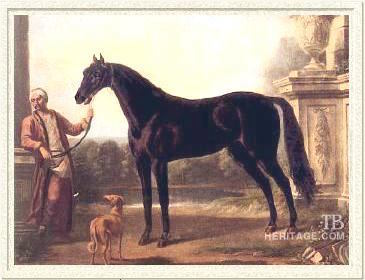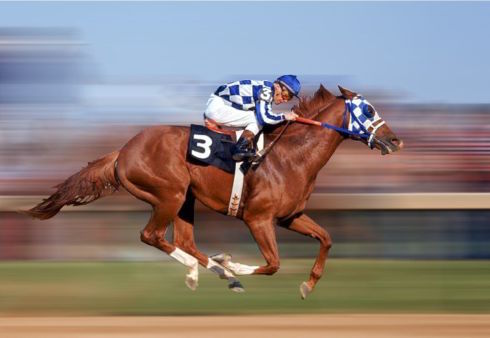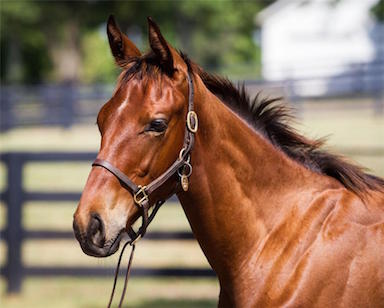Summary | Excerpt | Reviews | Beyond the Book | Read-Alikes | Genres & Themes | Author Bio

This article relates to Mercury
In Mercury, when Donald Stevenson sees the horse for the first time he says, "Mercury, true to his name, was unmistakably hot-blooded. The lines of his body, the arch of his neck, the rise and fall of his stride...were...beautiful."
 Horses, like dogs, are defined by breeds, and each have their own traits and purposes. Mercury is a Thoroughbred, and that breed, while commonly used in horse racing, also competes in show jumping, dressage, and other equine sports. Additionally, Thoroughbreds are part of the foundation of the American Quarter Horse, a western horse used for working cattle, racing, and pleasure riding.
Horses, like dogs, are defined by breeds, and each have their own traits and purposes. Mercury is a Thoroughbred, and that breed, while commonly used in horse racing, also competes in show jumping, dressage, and other equine sports. Additionally, Thoroughbreds are part of the foundation of the American Quarter Horse, a western horse used for working cattle, racing, and pleasure riding.
While no one can say for certain, the breed can be traced, supposedly, to three horses imported to England, each named for their owners. The Byerly Turk arrived in 1690, then came the Darley Arabian and then the Goldolphin Arabian. These horses were all stamina and speed, and from their breeding with native mares came the three "Thoroughbred" founding stallions: Eclipse, Matchem, and Herod.
According to the Encyclopedia Brittanica, the first Thoroughbred in the U.S. - then the British American Colonies – was a son of the Darley Arabian named Bulle Rock, who was imported to Virginia in 1730.
A Kentucky colonel named Sanders, (who had nothing to do with fried chicken), helped record the breed's American origins. Col. Sanders D. Bruce devoted himself to researching the Thoroughbred horses in America so that he could compile a registry of the pedigree in the United States. He used the General Stud Book of England as a pattern, and the first volume was published in 1873. Perhaps due to Col. Bruce, Kentucky's State Horse is the Thoroughbred.
 Nyquist, winner of the 2016 Kentucky Derby, can be found in that stud book, and no doubt can trace his ancestry back through the years to England. So it is with all the great American Thoroughbreds from Man O' War to Citation to Whirlaway, and, perhaps the very best of all, the magnificent Triple Crown winner, Secretariat.
Nyquist, winner of the 2016 Kentucky Derby, can be found in that stud book, and no doubt can trace his ancestry back through the years to England. So it is with all the great American Thoroughbreds from Man O' War to Citation to Whirlaway, and, perhaps the very best of all, the magnificent Triple Crown winner, Secretariat.
How great was Secretariat? Nyquist finished the one-and-a-quarter mile 2016 Derby at 2:01.31. Secretariat's 1973 time was 1:59.40 (measured, of course, before digital timing). That time is still the fastest ever. Two of the most famous horses of the twentieth century, Man o' War and Seabiscuit, were not entered in the Kentucky Derby. However, Citation, the great 1948 Triple Crown winner was, and finished in 2:05.40.
 The late Dick Schaap, a perceptive sports writer, noted "It's kind of ironic that the two sports with the greatest characters, boxing and horse racing, have both been on the decline. In both cases it's for the lack of a suitable hero." While many boxing fans are moving to mixed martial arts, horse racing received a minor boost in 2015 when Secretariat's great-great-great-grandson, American Pharoah, won the Triple Crown. But the sport, traceable back to three horses from the Middle East imported into England, still scrambles for the fan dollar.
The late Dick Schaap, a perceptive sports writer, noted "It's kind of ironic that the two sports with the greatest characters, boxing and horse racing, have both been on the decline. In both cases it's for the lack of a suitable hero." While many boxing fans are moving to mixed martial arts, horse racing received a minor boost in 2015 when Secretariat's great-great-great-grandson, American Pharoah, won the Triple Crown. But the sport, traceable back to three horses from the Middle East imported into England, still scrambles for the fan dollar.
Byerly Turk, courtesy of www.tbheritage.com
Secretariat, courtesy of myfavoritewesterns
American Pharaoh, courtesy of www.zayatstables.com
Filed under Cultural Curiosities
![]() This "beyond the book article" relates to Mercury. It originally ran in October 2016 and has been updated for the
June 2017 paperback edition.
Go to magazine.
This "beyond the book article" relates to Mercury. It originally ran in October 2016 and has been updated for the
June 2017 paperback edition.
Go to magazine.
Your guide toexceptional books
BookBrowse seeks out and recommends the best in contemporary fiction and nonfiction—books that not only engage and entertain but also deepen our understanding of ourselves and the world around us.